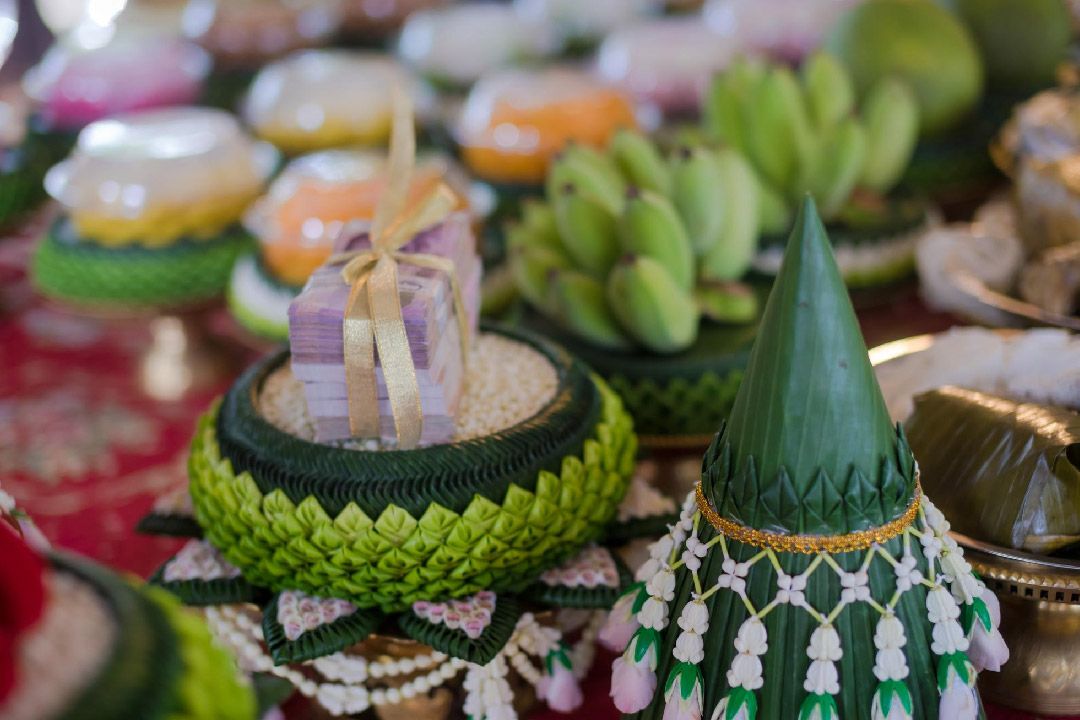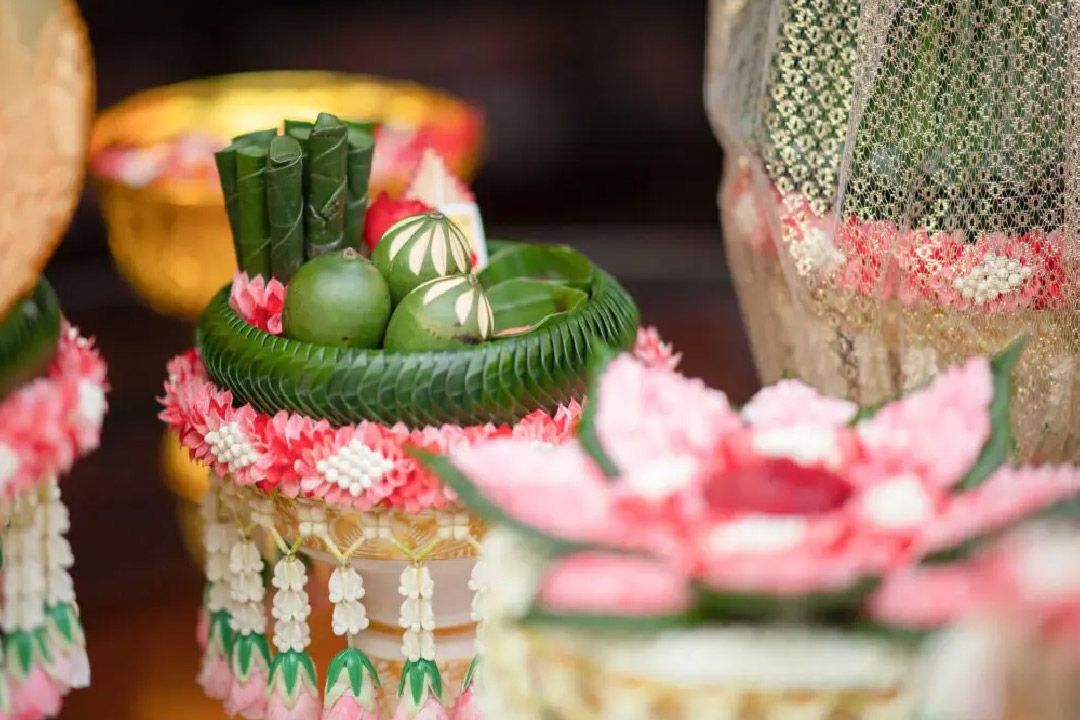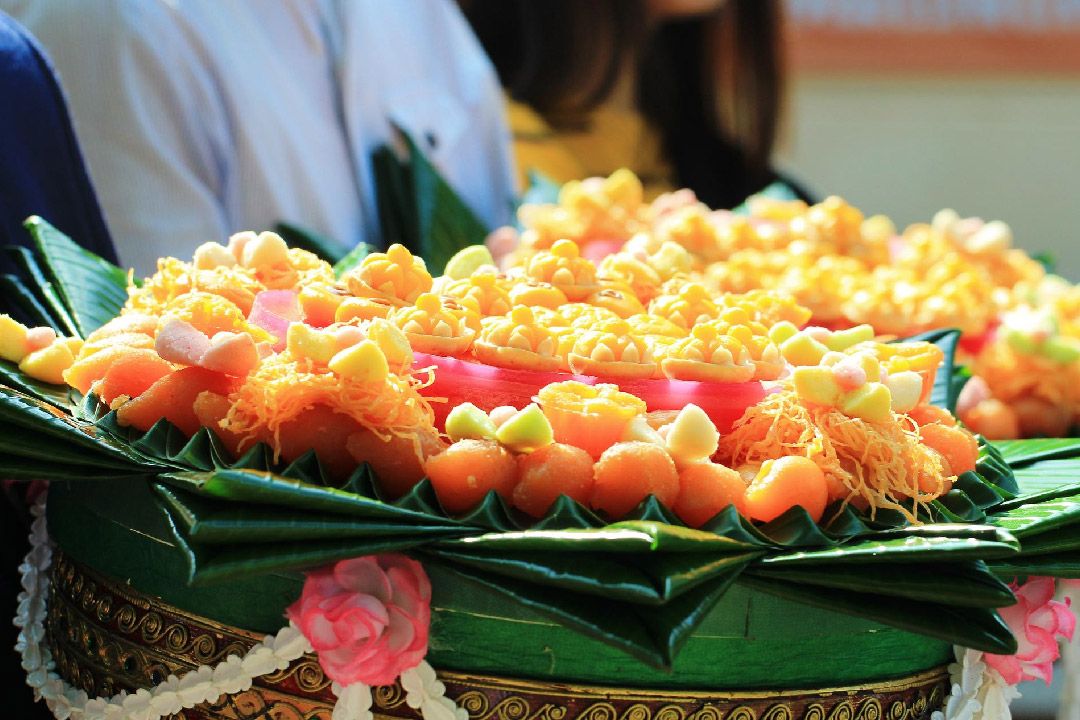The Meaning Behind Khan Mak in a Traditional Thai Wedding
|
A Traditional Thai Wedding Ceremony beautifully weaves together culture, spirituality, and family values. It all starts with the vibrant Khan Mak procession, where the groom’s family brings symbolic gifts to the bride’s home. Let’s take a closer look at the key traditions, their cultural significance, and how modern couples are adding personal touches to this timeless celebration.

What is a “Khan Mak” in a Thai Wedding Procession?
The Khan Mak Procession is a vital part of a traditional Thai wedding, symbolizing the groom’s journey to formally ask for the bride’s hand in marriage. The groom’s family brings a parade of offerings to present to the bride’s family, representing prosperity, good fortune, and respect.
The procession is made up of two main parts, Khan Mak Ek and Khan Mak Tho, each with its own symbolic meaning and significance.
Khan Mak Ek (Primary Khan Mak)
The Khan Mak Ek is considered the main offering set, containing essential items for formally asking for the bride’s hand in marriage. It is traditionally made up of four key trays, each holding symbolic significance.
- The Engagement Tray, presenting gifts and offerings.
- The Dowry Tray, showcasing money and gold.
- The Engagement Ring Tray, holding the engagement ring.
- The Candles and Incense Tray, used for blessings and ceremonies.
Khan Mak Tho (Secondary Khan Mak)
In a Traditional Thai Wedding, Khan Mak Tho refers to the set of ceremonial trays holding auspicious items for the wedding ritual. These typically include the Tray of Auspicious Sweets, Tray of Banana Trees and Sugarcane, and Tray of Auspicious Fruits, among others. The Khan Mak Tho set usually consists of:
- Tray of Nine Auspicious Sweets
- Tray of Boiled Chicken and Pork Belly on Banana Leaf
- Tray of Glass Noodles (1 pair)
- Tray of Coconuts (1 pair)
- Tray of Bananas (in pairs) and Oranges (1 pair)
- Tray of Pomelos (1 pair)
- Tray of Rose Apples (1 pair)
- Tray of Saneh Jan Sweets or Chinese Pastries (1 pair)
- Tray of Sweets for Distribution to Elders

The 19-Pair Khan Mak Tray: Symbolic Gifts in a Traditional Thai Wedding
The 19 Pair Khan Mak Trays are a traditional set of ceremonial trays prepared for the groom’s Thai wedding procession to formally propose to the bride. These 19 trays are carefully arranged with symbolic items, each carrying auspicious meanings and used during the wedding ceremony. The complete set includes:
- Main Khan Mak Tray (1 Tray) contains 2 betel trays, each with 8 betel nuts, 4 rows of betel leaves (8 leaves per row), 2 silver bags, 2 gold bags, with the bags containing green beans, black sesame seeds, paddy rice, popped rice, and 1 money envelope.
- Dowry Tray (1 Tray) Holds cash, gold, diamonds, or other valuable items representing the agreed-upon dowry between the two families.
- Engagement Ring Tray (1 Tray)
- Candle and Incense Tray (1 Tray)
- Invitation Tray (1 Tray) This tray is held by the bride’s side to formally receive the Khan Mak procession.
- Tray of 9 Auspicious Sweets (1-2 Trays) The sweets usually include Thong Yip, Thong Yod, Foi Thong, Thong Ek, Ja Mongkut, Saneh Chan, Luk Chup, Khanom Mor Kaeng, Khao Niew Daeng, Khao Niew Kaew, and Khanom Chan, but the selection may vary. These sweets represent prosperity and good fortune for the couple.
- Boiled Pork Tray (1 Pair)
- Boiled Chicken Tray (1 Pair)
- Khanom Pia Tray (1 Pair)
- Tray of Chinese Mixed Sweets (1 Pair)
- Tray of Fish-shaped Sweets (1 Pair)
- Khanom Gong Tray (1 Pair)
- Vermicelli Tray (1 Pair)
- Brown Sugar Tray (1 Pair)
- Steamed Sponge Cake Tray (1 Pair)
- Coconut Tray (1 Pair)
- Pomelo Tray (1 Pair)
- Banana and Sugarcane Tray (1 Pair each) Symbolizing prosperity and fertility, these plants represent good fortune in business and abundant offspring. They are usually small plants, carried by the groom’s side elders during the procession.
- Ancestor Worship Tray (1 Pair) This typically includes white liquor, white cloth, rice noodles, steamed curry, red rice cakes, and white rice cakes, though the exact items may vary depending on regional customs and beliefs.

Order of the 19-Pair Khan Mak Procession
The Khan Mak procession is quite elaborate, with 19 ceremonial trays carried in a specific order. Many may wonder how the procession is arranged and who should carry each tray. Traditionally, the groom leads the procession, followed closely by the matchmaker and young boys.
As the Thai wedding procession steps near the bride’s house, the matchmaker steps forward to formally represent the groom’s family. The groom carries a bouquet, floral garland, or a tray with candles and incense. Next are the groom’s parents or senior relatives, who carry the money envelopes. The order of the procession is as follows:
- A pair of banana and sugarcane plants
- Main Khan Mak trays, carried by senior relatives
- A pair of betel nut trays
- Dowry tray with gold and money
- Engagement ring tray and ceremonial candle & incense tray
- A pair of fabric gift trays for elders
- Secondary Khan Mak trays, carried by relatives or groomsmen
- A pair of boiled pork leg trays
- A pair of vermicelli noodle trays
- A pair of coconut trays
- A pair of banana, orange, and rose apple trays
- A pair of trays with 9 auspicious desserts
- A pair of trays with Sanay Chan sweets or traditional Chinese pastries
- A pair of trays with dessert boxes for relatives
- The procession concludes with a traditional dance performance

What is the significance of the Khan Mak in a Traditional Thai Wedding?
The Khan Mak procession holds great significance in a traditional Thai wedding. It not only involves the preparation of essential ceremonial items but also reflects symbolic beliefs associated with each item.
For example, the number of Khan Mak trays should be even, representing balance, while each item carries auspicious meanings — sugarcane symbolizes a sweet and harmonious marriage, banana trees signify fertility and a large family, and traditional Thai desserts are chosen for their names, which convey blessings and prosperity.
Another belief in traditional Thai wedding procession is that the senior relatives leading the procession should be respected individuals with happy and successful marriages, as this is believed to bring good fortune to the newlyweds. Additionally, the bride’s parents traditionally do not face the Khan Mak procession directly, as it is believed this could lead to future conflicts between the two families. These customs and beliefs are part of the symbolic rituals intended to bless the couple with a long and happy marriage.

Can you have fewer than 19 pairs in a Khan Mak Ceremony, and how is it done?
The arrangement of the 19 Khan Mak pairs varies depending on local traditions and beliefs. Some couples may prepare only 9 pairs, or omit certain trays altogether. However, the essential items that should always be included in the Khan Mak Thai wedding procession are the main Khan Mak tray, banana and sugarcane plants, auspicious dessert trays, the bride price, and essential ceremonial items such as the gift trays for honoring the elders.
How to divide the gifts in a Khan Mak after a Traditional Thai Wedding?
The Khan Mak trays are usually divided equally between both families. The groom’s side will distribute their portion to guests attending the ceremony. However in a modern Thai wedding procession, some items should always be left on the trays as a symbolic gesture.

Can married couples or singles eat the sweets from the Khan Mak?
This belief differs from one person to another. However, the sweets in the Khan Mak Thai wedding procession are considered auspicious and specially prepared for the ceremony, so they are perfectly fine to eat. Ultimately, these traditions depend on local customs and individual beliefs.
Conclusion
The Khan Mak is an essential part of a Traditional Thai Wedding, symbolizing the formal proposal and the union of two families. The procession includes ceremonial trays (Khan Mak Ek and Khan Mak Tho) filled with auspicious items such as betel nuts, banana trees, sugarcane, money, and traditional sweets. Each represents prosperity, fertility, and good fortune. The procession is led by the groom, followed by senior relatives, matchmakers, and family members. The number and types of trays may vary by region and family customs, but every item carries symbolic significance to bless the couple’s married life.
The Khan Mak procession can be adjusted to suit each couple’s preferences and local traditions. With proper preparation, the ceremony will be filled with joy and cherished moments. For couples seeking a picturesque wedding venue surrounded by nature, Rancho Charnvee Resort & Country Club offers a full range of services to make your special day truly unforgettable.

